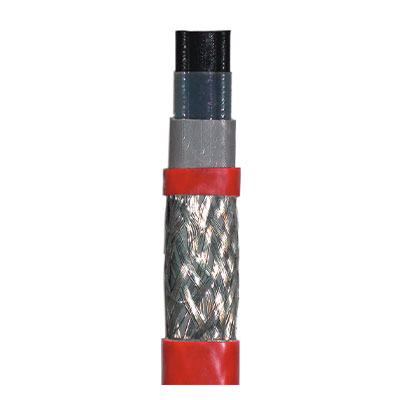SRM-2-CT
FineKorea SRM-2-CT self-regulating braided heating cable
The heating cable of the "SRM-2-CT" series, presented on the company's website Online Energy, is used to maintain the temperature and viscosity of pumped liquids (oil, chemicals, etc.).
PTC cable "SRM-2-CT" shows excellent ability to maintain the temperature of horizontal pipelines and vertical pipes in industrial plants and manufacturing plants.
 FineKorea's SRM series cables, using the PTC principle, regulate their own output power according to the ambient temperature, thereby reducing the risk of fire from overheating.
FineKorea's SRM series cables, using the PTC principle, regulate their own output power according to the ambient temperature, thereby reducing the risk of fire from overheating.
The core of the cable and the thermal insulation jacket of the cable are vulcanized, which ensures excellent heat resistance of the cable even at rising temperatures. In addition, the "SRM" series cable can operate in both hazardous and non-hazardous areas, as the cable's tinned copper braid can be grounded.
Design of FineKorea SRM-2-CT cable from Online Energy
 1. Copper bar.
1. Copper bar.
2. Self-regulating conductive core.
3. Modified polyolefin insulation.
4. Tinned copper braid (CR).
5. Fluoroplastic external thermal insulation (ST).
Key advantages of SRM cables
- Long service life (semi-permanent). During the manufacturing process, the cable is additionally treated at elevated temperature with intermediate annealing to give it stability without loss of thermal output during its entire service life.
- Low power consumption. The low power consumption of the cable is due to its unique positive temperature coefficient (PTC).
- Excellent temperature resistance. During the manufacturing process, the cable is cross-linked and vulcanized to provide the same thermosetting properties as XLPE (cross-linked molecular structure).
- Cut to desired length. The cable core consists of endless parallel bonds of carbon particles, which allows the cable to be cut to exactly the desired length.
Residual current circuit breaker protection and maximum circuit length
220 V| Start temperature | ||||
|---|---|---|---|---|
| 15 A | 20A | 30A | 40 A | |
| 10 0C | 80 | 95 | 120 | - |
| 0 0C | 70 | 85 | 100 | 120 |
| -20 0C | 55 | 70 | 90 | 110 |
| - 400C | 45 | 60 | 80 | 100 |
